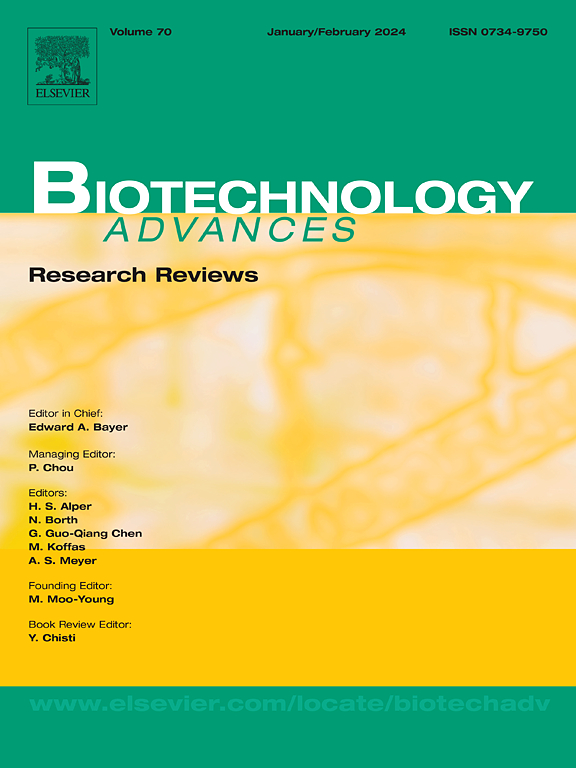纳米孔直接RNA测序的研究进展及其对生物学研究的影响
IF 12.5
1区 工程技术
Q1 BIOTECHNOLOGY & APPLIED MICROBIOLOGY
引用次数: 0
摘要
纳米孔直接RNA测序(DRS)是一种变革性技术,可实现天然RNA的全长单分子测序,捕获转录异构体并保留不需要cDNA转换的表转录组修饰。本文概述了DRS的主要进展,包括mRNA、rRNA、tRNA、circRNA和病毒RNA的优化方案,以及用于异构体定量、聚(A)尾测量、融合转录物鉴定和碱基修饰分析的分析工具。我们强调DRS如何重新定义了不同系统中的转录组学研究——从发现癌症、植物和寄生虫中的新转录本和替代剪接事件,到能够直接检测m6A、m5C、假尿嘧啶和RNA编辑事件。新兴的应用,如共转录剪接分析,lncRNA和circRNA的发现,实时RNA结构作图也进行了讨论。除了基础研究,DRS在mRNA疫苗质量控制和基于rna的数据存储方面提供了强大的能力。尽管目前在测序精度、输入要求和成本方面存在限制,但纳米孔化学、基调用算法和机器学习集成方面的持续改进正在迅速扩大DRS的应用范围。随着技术的成熟,DRS有望成为高分辨率转录组分析、RNA调控分析和综合多组学应用的核心平台,为基因表达、调控和进化提供新的见解。本文章由计算机程序翻译,如有差异,请以英文原文为准。
Advances in nanopore direct RNA sequencing and its impact on biological research
Nanopore direct RNA sequencing (DRS) is a transformative technology that enables full-length, single-molecule sequencing of native RNA, capturing transcript isoforms and preserving epitranscriptomic modifications without cDNA conversion. This review outlines key advances in DRS, including optimized protocols for mRNA, rRNA, tRNA, circRNA, and viral RNA, as well as analytical tools for isoform quantification, poly(A) tail measurement, fusion transcript identification, and base modification profiling. We highlight how DRS has redefined transcriptomic studies across diverse systems—from uncovering novel transcripts and alternative splicing events in cancer, plants, and parasites to enabling the direct detection of m6A, m5C, pseudouridine, and RNA editing events. Emerging applications such as co-transcriptional splicing analysis, lncRNA and circRNA discovery, and real-time RNA structural mapping are also discussed. Beyond basic research, DRS offers powerful capabilities in mRNA vaccine quality control and RNA-based data storage. Despite current limitations in sequencing accuracy, input requirements, and cost, ongoing improvements in nanopore chemistry, basecalling algorithms, and machine learning integration are rapidly expanding DRS utility. As it matures, DRS is poised to become a core platform for high-resolution transcriptome profiling, RNA regulatory analysis, and integrative multi-omics applications, offering novel insights into gene expression, regulation, and evolution.
求助全文
通过发布文献求助,成功后即可免费获取论文全文。
去求助
来源期刊

Biotechnology advances
工程技术-生物工程与应用微生物
CiteScore
25.50
自引率
2.50%
发文量
167
审稿时长
37 days
期刊介绍:
Biotechnology Advances is a comprehensive review journal that covers all aspects of the multidisciplinary field of biotechnology. The journal focuses on biotechnology principles and their applications in various industries, agriculture, medicine, environmental concerns, and regulatory issues. It publishes authoritative articles that highlight current developments and future trends in the field of biotechnology. The journal invites submissions of manuscripts that are relevant and appropriate. It targets a wide audience, including scientists, engineers, students, instructors, researchers, practitioners, managers, governments, and other stakeholders in the field. Additionally, special issues are published based on selected presentations from recent relevant conferences in collaboration with the organizations hosting those conferences.
 求助内容:
求助内容: 应助结果提醒方式:
应助结果提醒方式:


